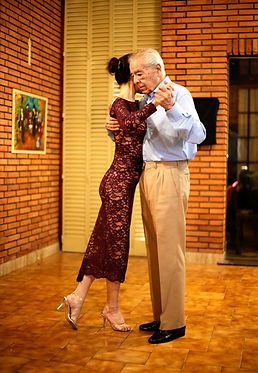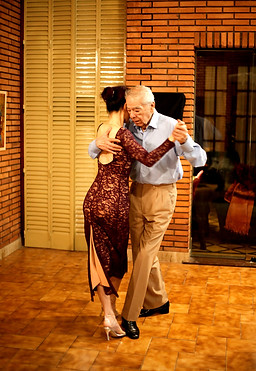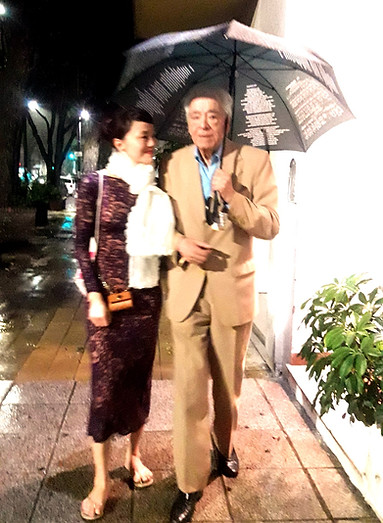
Birthing
Documentary Film
A Tango with Chino Perico

A Tango with Chino Perico is an interview style documentary film, independently produced, directed and hosted by J. Wang, the President of Tree Knows Media Canada Inc..
In March of 2020, at the onset of the global outbreak of the COVID -19 pandemic, Wang was in Buenos Aires, Argentina, doing Tango research for the upcoming film The Tree Knows. Chino Perico is a legendary Milonguero in his 90s, well known as elegant “El Chino” in the Argentine Tango community. Carrying forward in the “Villa Urquiza” style, Chino has been dancing Tango for over seventy years and shows up at Milongas almost every night. Encountering Wang on the dance floor, Chino was drawn to her graceful move. Their rendezvous on the dance floor sparked a deep conversation across generations, cultures, races and genders. “EI Chino’s” recollection of his lifelong devotion to Tango spoke with a sense of life wisdom. He recounts some of the most amazing dancers’ performances that are quintessential and breathtaking. Watching this documentary is a rare Tango experience.
The film was shot before the city-wide lockdown of Buenos Aires due to COVID-19. Despite the challenges of global isolation making the post production challenging, the film lives up to its expectations. Made with craftsmanship, like a charming gem, it radiates with love and dedication to the art of Tango. The film has already won its first award, the 2020 IndieFest Film Award for Special Purpose Production. (© reserved)
J. Wang on A Tango with Chino Perico
At the heart of the Argentine Tango, it is the desire to embrace, listen, and understand the inner voice of the person you are dancing with through the dramatic Tango music and the intimate body language.
A Tango with Chino Perico is a conversation piece between a traditional Milonguero and a modern feminist filmmaker. Despite our mutual admiration for each other's dance, Chino's conservatism and my modernity inevitably collided. The stark differences of our generations, cultures, races, and genders created a strong desire for conversation. It's really amazing that two completely different individuals can dance and console each other as if in unison within the dramatic music! — That’s Tango!
In particular, this film is dedicated to the year 2020. The scourge of the coronavirus pandemic has made us all the more eager to embrace each other, but cannot. So here, I dedicate this film to you. It's like a Tango, composed of hugs, alive for love. I hope that in the near future we will embrace each other tighter and love stronger!






Mañana / Tomorrow
J. Wang’s Interview notes on A Tango with Chino Perico
Many years ago in my 20’s, I was a columnist for a media newspaper. Before airing my TV talk show, I would publish my interview notes in the newspaper, explaining why I chose the guest and how I did the interview. I always believed that the reason and process were more important than the result. Therefore, here are my notes for the interview documentary, A Tango with Chino Perico, I newly produced in 2020.
Chino Perico in his nineties is a legendary Milonguero who is well known as the elegant “EI Chino" in Argentine Tango community. He has carried forward the"Villa Urquiza" style and been dancing Tango for over 70 years. More importantly, he is still active at the milongas almost every night. I met Chino on my first Tango trip to Buenos Aires in 2014. My innate shyness often led me to sit alone in the corner instead of following milonga etiquette of greeting friends and elders. I never took the initiative to greet the famous “El Chino". Chino and I officially greeted each other in March 2019 during my fourth year of Tango research in Buenos Aires for my next film The Tree Knows, which coincided with 2019 CITA International Tango Festival.
The La Viruta Milonga during the CITA was packed with energetic dancers. Champions from all over the world showed their talents on the floor after 3 a.m. My partner that night was a handsome young champion from Brazil. We danced three Tandas at a stretch full of energy. During the D’Arienzo, my high heel banged against a table leg in a flying “boleo”. I heard the crash of ice cubes in the champagne bucket. Chino sat at the table, holding his glass tightly, with anger in eyes. He hates young dancers jumping around. Kicking his table was like "throwing sand in his eyes". We apologetically bowed and went on dancing crazily. As Agostino Vargas played, I took a rest, noticing Chino eyeing on me. I looked away avoiding his blame. A few minutes later, Chino stood beside me, ” Vamos a bailar!" I didn't understand what he was saying and extended my hand to him to apologize, "So sorry I kicked your table!" Then he said a great deal in a solemn manner. I guessed that he must have criticized me for dancing too fast, too hard and breaking traditions etc.. But he ended with "Muy Buena Bailarina!" (Very good dancer!) "What? Are you complimenting me?” I’m confused. Getting no response from me, Chino shook my hand and walked towards the bar. The people around me must have been thinking, "This arrogant Chinese girl refused the master with a handshake!" Anyway, this was my first formal greeting with Chino, a complete “across cultural misunderstanding”! Long afterwards I knew that Agostino Vargas is Chino’s favourite Tango musician.
I thought Chino would not give me any attention after my “handshake rejection”. However, on the way home after the milonga, I bumped into Chino and a middle-aged male dancer who were walking to the bus stop. The two gentlemen took a circuitous route and escorted me home. I thanked Chino, he responded to me warmly: “De nada. ¡En Tango somos familia! Mañana!” (You're welcome. In Tango we are family! See you tomorrow!)
A few days later, Chino met me at a milonga and complained, “Dijimos ‘Mañana’ y desapareciste por unos días!” (“We said ‘See you tomorrow’ and you disappeared for a few days!”) My Spanish not being strong, I responded with a shy smile. Chino invited me to sit next to him, and I offered him a glass of champagne. Little did I know that there are many rules at a milongueros’ table. For one, the ladies who accompany milongueros could not accept other people's invitations to dance! Unbounded feminist me danced to all the invitations from the good dancers. Chino’s face was sullen.
Not long after, one Saturday night, with my hosts Carlos Stasi and Joan Vitale, we bumped into Chino again at another milonguero's birthday party. After a traditional barbecue dinner, we decided to go to Cachirlulu Milonga together. Chino and I took one taxi. Halfway there, Chino changed his mind and decided to show me his “family milonga". However, he forgot the street number and the driver was unable to find it. I offered Chino to find the address through the Hoy Milonga app on my phone. He laughed at me trusting his old blind eyes. As the driver was circling, Chino complained that young Argentinians have lost their roots! He angrily asked the taxi to stop and decided to walk. I, a foreigner with no sense of direction, wandered on the gravel road with the 90ish elder. Suddenly, like entering Woody Allen's Midnight In Paris, troubled from Sofia Coppola’s Lost in Translation, after a long walk, as I hurt my foot, Chino waved his hand and pointed ahead: "Mira, EI Rodriguez!”
EI Rodriguez was like an ocean of white hairs. As if back the Tango golden age, the floor was mainly controlled by milonguero style mixed with few traditional salon dancers, dress code - dark! The rough marble floor was huge and sticky, obviously no money for maintenance. Almost everyone came over greeting Chino. I was treated as an honoured guest, not only receiving many hugs and wet kisses, but also free wine, free whisky, and a free massage from a professional therapist, an old buddy of Chino’s. Of course, no one dared to “steal” me from Chino’s table! He is the oldest patriarchy of the family! We danced almost every Tanda, with the elderly Chino acting like a rejuvenated man. After the last Tanda, we said “Mañana” as our tradition to each other, but it was the last time I appeared in the Minlonga during my 2019 trip.
In January 2020, I visited Buenos Aires again with my The Tree Knows script to rehearse the dance scenes with my favourite choreographer. In addition to meetings, classes and rehearsals, I often hung out at nightly milongas. One night at Salon Canning, Chino greeted me: “Mañana, Mañana, has estate desaparecido por case un ańo! (“Tomorrow, tomorrow, you had been missing for almost a year!”) Oh, Mamamia! A year later, he still remembered “Mañana”! History repeated itself. I upset him again by dancing with other people! Born with the eastern ritual of respecting the elder, I felt bad upsetting Chino, but how could I deliver my unbridled feminist message to the oldest conservative Milonguero in the face of a language barrier, generation gap and cultural difference? After much deliberation, I had no better choice than to refuse to sit next to him and deliberately huddle with my young friends. This unexpectedly hurt his pride, Chino was angry.
Over the dinner, I was talking to Carlos and Joan about the standoff between Chino and me. Carlos said, "Come on, don't forget he's a Milonguero, let him be!” I had a whim: "Our Chinese saying, ‘enemies should be solved rather than settled’. Let me do an interview for Chino!" Then Carlos told Chino about it, and Chino readily agreed. I started organizing professional photographers and studios etc..
As we were to begin, the coronavirus started to spread in Buenos Aires. The photographer I booked got sick and the studio was closed. My own dance trainings and rehearsals had to stop. I decided to invite Monteleone, the Tango photographer, to shoot the interview as fast as possible at his studio and in Carlos's house. The day before the shooting, I had an acute gastritis attack and sleepless night. On the shooting day, Monteleone had taken medication for an upcoming medical examination and had to run the toilet every ten minutes. There were only three lights in the studio, the middle one went off during the shoot, my face dimmed beyond repair. All the light must be focussed on Chino. Carlos could only contribute his profile in the shadows, thanks for his magnanimity. The epidemic is like a war, before the battle outbreak, such people still served the filmmaker for the art! Grateful!
The filming was on and off due to various technical glitches. I raised questions in English, Chino answered in Spanish, and Carlos translated in both languages. The duration was several times longer and slower than normal interviews. We talked about Tango history, tradition, etiquette, spirit, new Tango and modern women. May not appear that deep, but is proved to be very interesting. I respect Chino's sincerity, even though I don't entirely agree with some of his points. That's the meaning of our interview, each airing our own view and getting to know each other better. Hearing Chino's hungry stomach, I suddenly realized that I shouldn't overwork the senior. Later, Chino joked with me: "You were like a cop torturing a criminal. I couldn’t figure out what I had done wrong!" I challenged back, "I'm not a cop, I'm a feminist! If you had known I was a feminist, would you have asked me to dance?” He shrugged, “Absolutely not! But now it's too late!”
A few days later, we heard of all the milongas would be soon be closed, I stopped by La Viruta to check out the situation. Ran into Chino, who pulled out the chair beside him to let me sit down. I thought, “with the injured foot and the floating epidemic in the air, June, tonight you’d better obey and sit beside him, listen to the music and watch the dance. Don't upset him anymore.” Pleased with my quietness, Chino was excited, reciting the Tango lyrics to me. Pretending that understood him well, I smilingly nodded. Suddenly, at the other end of the table, a well-dressed man cabaceo-ed me and asked me to dance. The man is an acquaintance who had been out of dancing since his wife gave birth to a new baby. His wife is also a Chinese woman. So how could I refuse such an invitation? Without second thought, jumped on the floor, we D’Arienzo-ed! This man has the similar energy as that Brazilian champion and we almost kicked Chino’s table several times! Chino couldn't take it anymore, hobbling out of the milonga, with cigarette twisted in hand.
I found Chino smoking a cigarette at the milonga door. Waving his shaking hand, he lectured me solemnly. I tried to understand his speech through a mobile translator, but he pushed my phone away. A friend of Carlos stepped in and typed Chino's message into my phone: "Tonight you and the guy broke the code of our traditional milonga. He shouldn't have asked a lady who is in the company of another man to dance, and you shouldn't have accepted his invitation!” “Mamamia!” I thought to myself, “Same cliche again! What a turn down for a feminist!" The cigarette butt burnt his finger, angry like a child, he still organized his silver hairs in a meticulous manner! That moment reflected the dearest image of Chino: elegant dancer, warm friend, stubborn patriarchy, childlike soul! Such a man, experienced enough vicissitudes, still so emotional! I burst out laughing and cabaceo-ed Chino with the few Spanish words in my command: “Vamos a bailar!” (Let’s dance!) Chino was stunned. A reserved feminist had never asked a guy to dance! If I inadvertently turned down Chino's first invitation, that night was my turn to pay my respect. I winked my eye and repeated, “Vamos a bailar!” The irritation in Chino's eyes disappeared and a shy smile shined. He stamped out his cigarette, grabbed my hand, and walked happily onto the dance floor. After the last Tanda, we bid farewell to each other with the “Mañana” tradition that has been never fulfilled.
Soon after, all the milongas were all closed and we never had the chance to meet again.
Today, more than 9 months have passed, I wish that Argentina, Chino and all my Argentine friends are safe and well. This simple impromptu interview unexpectedly won the Special Purpose Production Award in the 2020 International Independent Film Festival (IndieFest). This is a sweet consolation for my year of 2020. I guess the reason for the award is that the original intention of the film is simple and pure; the content is unadorned. The production is not perfect, but to the point. In the nine months of continuous isolation, my resources were limited. If there is any defect, please forgive me! Speaking of the “Special Purpose” of the film, it’s to spread the spirit of unison that I’ve been given through the Tango experience.
Finally, thanks to all my friends who have helped on this film! Thanks to the year 2020, which has strengthened my will! May we hold on to the original intention of our desire and embrace Mañana with hope!

Tango is a piece of life in which we are family!
-- Chino Perico


This film is dedicated to the year 2020.